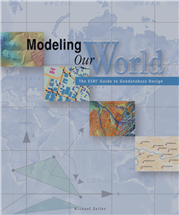PREFACE ........................................................................................................................... vii
ACKNOWLEDGMENTS ............................................................................................. ix
CHAPTER 1: OBJECT MODELING AND GEODATABASES ........................ 1
Modeling objects with GIS ...................................................................................... 2
The progress of geographic data models .............................................................. 4
The geodatabase, store of geographic data........................................................... 8
Features in an object-oriented data model ...........................................................10
Serving geographic data .........................................................................................12
Accessing geographic data.....................................................................................14
Building data models..............................................................................................16
Guide to reading UML object diagrams ................................................................19
Technology trends ..................................................................................................21
CHAPTER 2: HOW MAPS INFORM...................................................................... 23
The utility of maps ..................................................................................................24
How maps present information .............................................................................25
The parts of a map .................................................................................................27
Presenting geography with layers ......................................................................... 28
Drawing features with symbols............................................................................. 30
Drawing feature layers............................................................................................32
Classifying attribute values .....................................................................................36
Displaying thematic, spectral, and picture data....................................................38
Visualizing surfaces with TIN layers .....................................................................41
CHAPTER 3: GIS DATA REPRESENTATIONS ................................................... 45
The fundamentals of a GIS....................................................................................46
The diverse applications of GIS ............................................................................48
Three representations of the world .......................................................................51
Modeling surfaces.................................................................................................. 52
Modeling imaged or sampled data ........................................................................54
Modeling discrete features .....................................................................................56
Comparing spatial data representations ................................................................58
CHAPTER 4: THE STRUCTURE OF GEOGRAPHIC DATA........................ 61
The catalog and connections to data....................................................................62
The geodatabase, datasets, and feature classes ...................................................64
ArcInfo workspaces and coverages ..................................................................... 66
Shapefiles and CAD files ........................................................................................68
Maps and layers ......................................................................................................70
Comparing the structure of vector datasets ..........................................................72
Comparing feature geometry in vector datasets ...................................................73
CHAPTER 5: SMART FEATURES ............................................................................. 75
The qualities of features .........................................................................................76
Steps to making features smart ............................................................................. 78
Designing the geodatabase ....................................................................................80
Storing data in tables ..............................................................................................82
The shape and extent of features......................................................................... 84
Attributes: qualities of an object ............................................................................86
Adding simple behavior with subtypes.................................................................88
Validating attributes .................................................................................................90
Relationships among objects .................................................................................92
Extending object classes ........................................................................................96
The geodatabase object model............................................................................. 98
CHAPTER 6: THE SHAPE OF FEATURES ........................................................ 101
Geometry and features .........................................................................................102
Constructing geometry ..........................................................................................105
Testing spatial relationships .................................................................................110
Applying topological operators............................................................................112
Geometry object model........................................................................................114
CHAPTER 7: MANAGING WORK FLOW WITH VERSIONS ................. 115
Using versions .......................................................................................................116
Long transactions and the geodatabase ..............................................................118
The fundamentals of versions .............................................................................120
Editing versioned geodatabases...........................................................................122
Types of work flows .............................................................................................124
CHAPTER 8: LINEAR MODELING WITH NETWORKS ........................... 127
Modeling infrastructure ........................................................................................128
The network model ..............................................................................................130
How features connect ..........................................................................................132
Network features ...................................................................................................134
Network flow .........................................................................................................139
Analysis on a network ..........................................................................................142
Network object model ..........................................................................................145
CHAPTER 9: CELL-BASED MODELING WITH RASTERS ........................ 147
Representing geography with rasters ...................................................................148
Using raster data....................................................................................................150
Raster data model .................................................................................................152
Raster display and analysis ..................................................................................154
The spatial context of rasters ...............................................................................156
Raster formats ........................................................................................................158
Raster object model ..............................................................................................160
CHAPTER 10: SURFACE MODELING WITH TINS ...................................... 161
Representing surfaces ...........................................................................................162
Structure of a TIN .................................................................................................164
Modeling surface features ....................................................................................166
